Key takeaways:
- Storytelling in activism effectively fosters empathy and connection, transforming personal narratives into collective action.
- Authenticity and emotional engagement are crucial for impactful storytelling in both activism and discussions on reparations.
- Historical narratives and personal stories highlight the urgency for reparative justice, making abstract concepts feel relatable and necessary.
- Diverse voices and relatable metaphors can enrich storytelling, amplifying messages and inspiring community commitment to change.
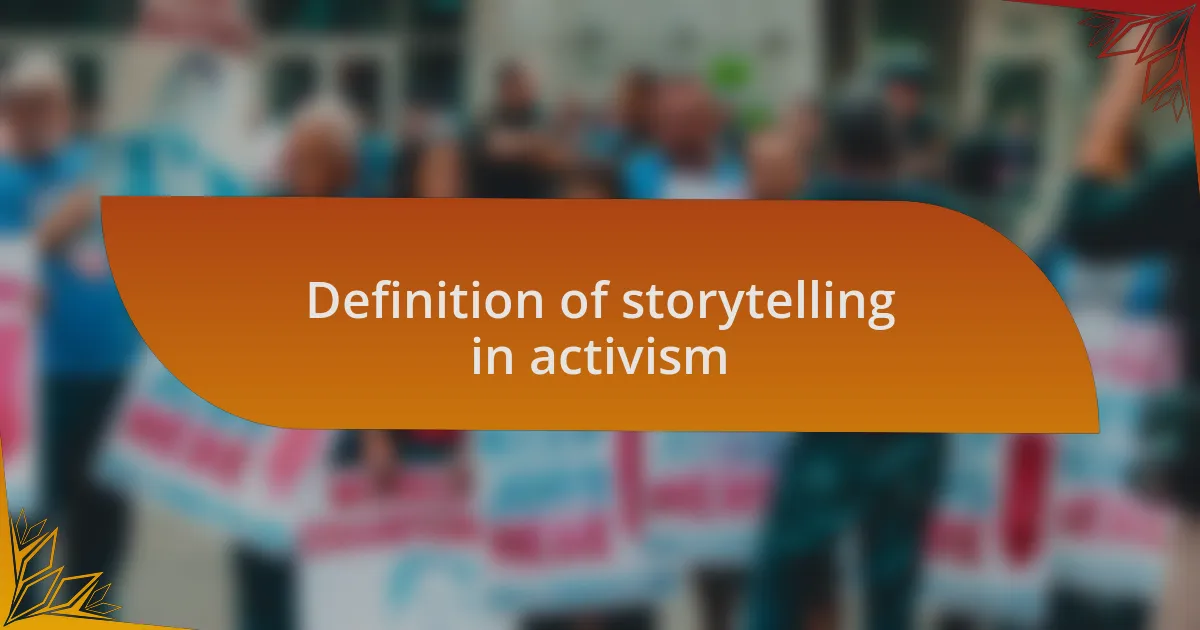
Definition of storytelling in activism
Storytelling in activism is the art of sharing narratives that resonate with people’s experiences, aiming to inspire change and mobilize communities. It’s not just about relaying facts; it’s about weaving emotions into the fabric of advocacy, making the message relatable and human. I often find that when I share a story—like the time I attended a rally where a fellow activist shared her family’s history of displacement—it resonates on a deeper level than statistics ever could.
What makes storytelling so powerful in activism is its ability to foster empathy and connection. Have you ever felt moved by someone’s personal journey? I certainly have. It’s as if their struggle becomes a part of your own. This emotional engagement can transform passive listeners into active participants, encouraging them to join the cause and champion the message further.
In essence, storytelling serves as a bridge between the personal and the political, transforming experiences into collective action. I’ve seen firsthand how a well-told story can illuminate the stark realities of injustice, creating a shared understanding among individuals from diverse backgrounds. Doesn’t that spark a sense of urgency to act?
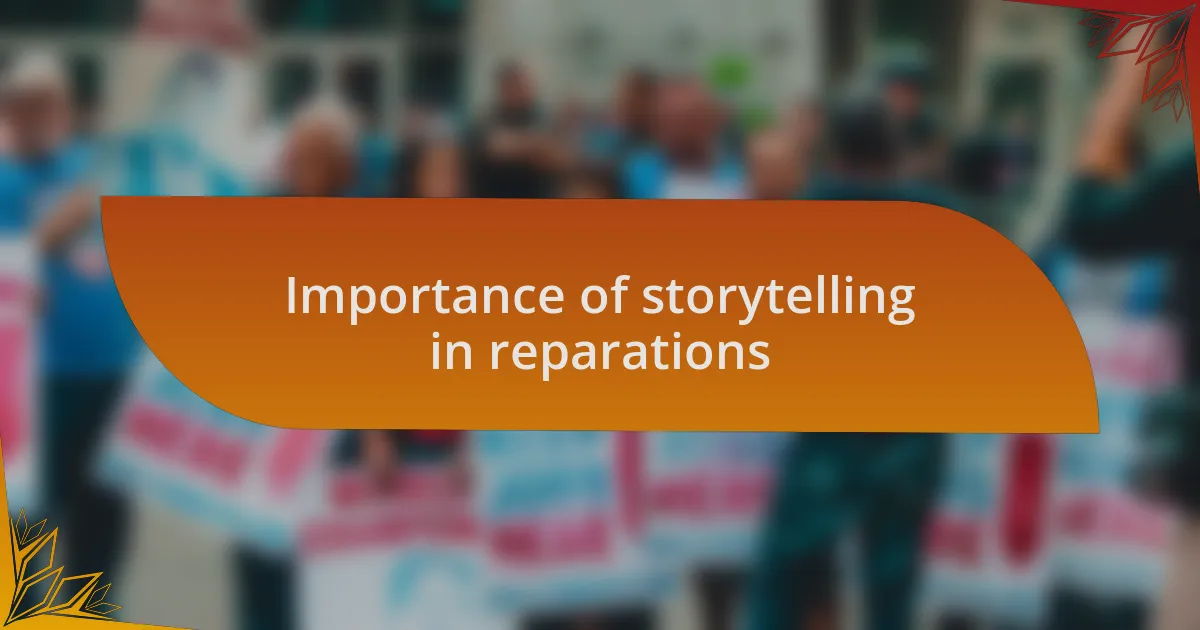
Importance of storytelling in reparations
Storytelling plays a crucial role in reparations as it brings historical injustices to life, allowing individuals to connect with the past in a personal way. I remember attending a community workshop where a participant recounted their grandparents’ experiences with discrimination and economic disenfranchisement. Hearing that story made the concept of reparations feel real and compelling, transforming abstract ideas into relatable human experiences.
When we share stories about those affected by systemic injustice, we create a platform for voices that have long been marginalized. It strikes me that these narratives often challenge the dominant historical narratives, pushing us to confront uncomfortable truths. Have you ever felt a shift in your perspective after hearing someone’s personal account? I certainly have; those moments of realization can be pivotal in understanding the need for reparations.
Additionally, storytelling can bridge generational gaps in the reparations conversation. As someone who has spoken with younger activists about their grandparents’ resilience, I’ve seen how these stories foster a sense of responsibility in the new generation. Isn’t it powerful to know that through storytelling, we can inspire future advocates to carry forward the legacy of those who fought before them?
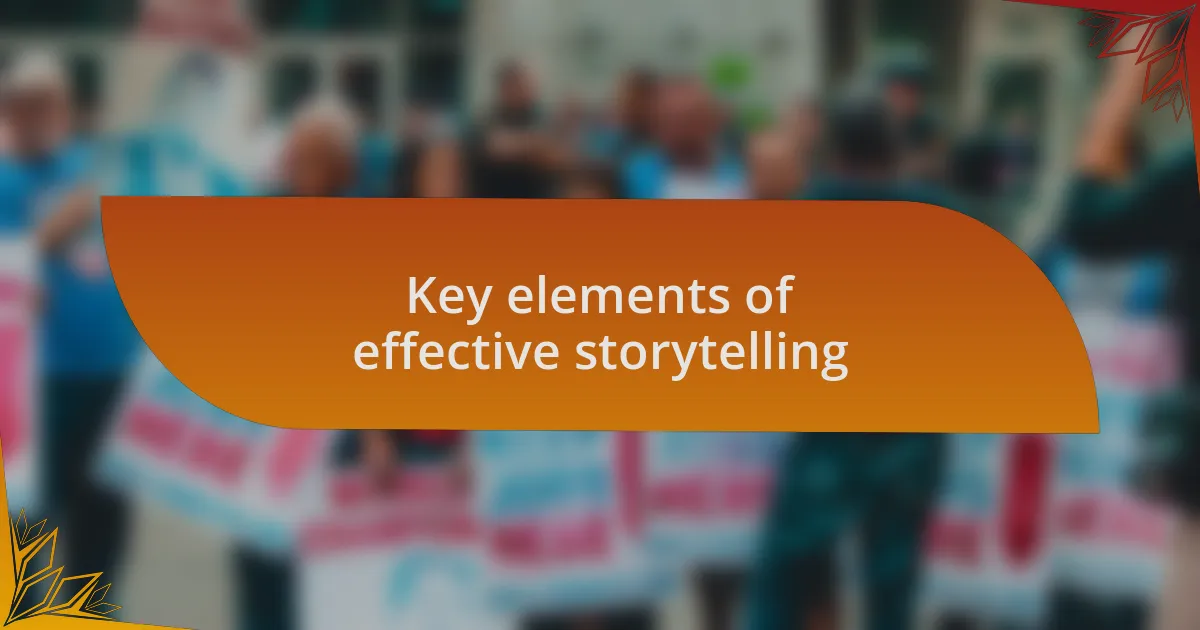
Key elements of effective storytelling
To craft compelling stories, authenticity is paramount. I’ve found that sharing genuine experiences, whether personal or third-party, resonates on a deeper emotional level. When I listen to activists recount their journeys, it’s the rawness—the triumphs, the failures, the vulnerability—that pulls me in and makes their message stick. Have you ever had a moment when someone’s candid truth hit you squarely in the heart? Those moments remind me how critical it is to be real.
Another key element is narrative structure. A well-structured story guides the audience through a beginning, middle, and end, creating an arc that is satisfying and memorable. I once heard a seasoned advocate reflect on their early days in activism, detailing conflicts and resolutions that not only captivated listeners but also provided clear lessons on perseverance. This approach makes the story relatable and actionable. How can one not feel inspired after hearing about a challenge turned into a victory?
Visual imagery is also a vital component of effective storytelling. When I share about living in neighborhoods shaped by economic inequality, I often paint a vivid picture of the streets, the sounds, and the faces of those affected. This imagery doesn’t just inform; it immerses the audience, enabling them to feel as if they are walking alongside me through these experiences. Isn’t it amazing how our minds can travel to places we’ve never been through the power of language alone? Engaging the senses can turn passive listeners into active participants in the narrative.
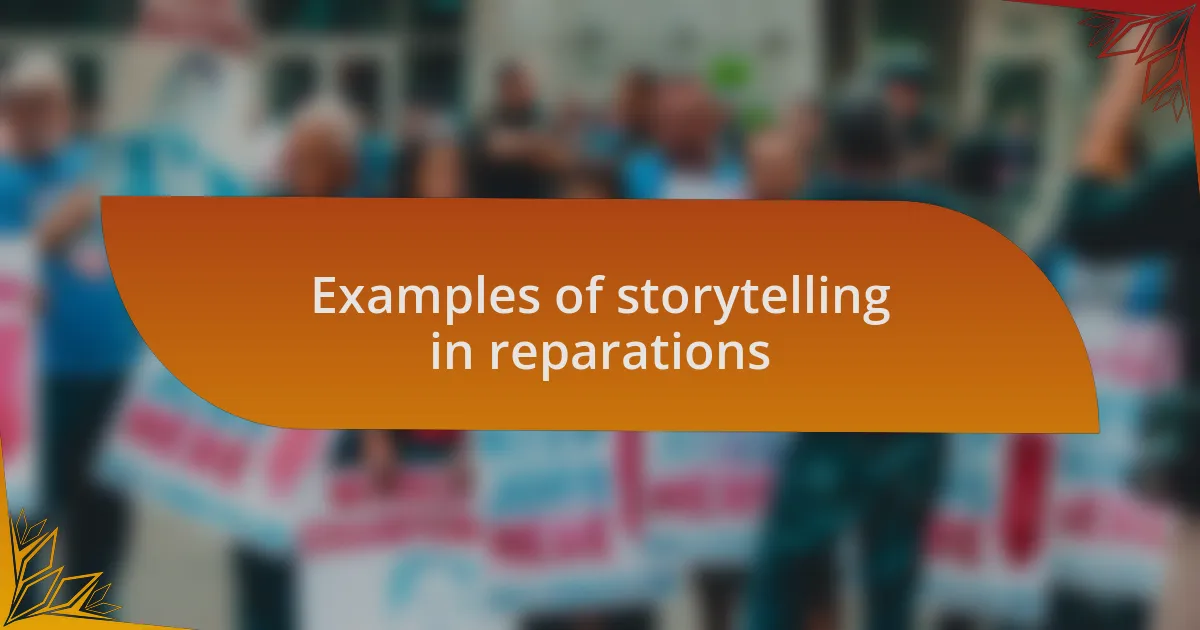
Examples of storytelling in reparations
I recall one powerful instance where a community member shared their family’s history, detailing the enduring impact of systemic injustices on subsequent generations. This narrative not only highlighted the struggles faced but also painted a vivid picture of their resilience. Can you imagine how hearing their story brought a human face to the often abstract concept of reparations, making it feel urgent and necessary?
There’s also remarkable strength in storytelling that focuses on historical events. I remember attending a workshop where speakers recounted their ancestors’ experiences with forced labor. Each tale unfolded with layers of emotional weight, making it impossible to overlook the urgency for reparative justice. Listening to these histories transformed my understanding; it felt like standing in the shoes of those who lived through these injustices. How could anyone not feel the ripple effects of such profound stories?
Another memorable example comes from a grassroots campaign that used storytelling to humanize their call for reparations. They showcased video montages of individuals directly impacted, sharing their dreams, hopes, and ongoing struggles. I found this format compelling because it blended visual storytelling with personal anecdotes, creating a relatable narrative that resonated deeply. Isn’t it remarkable how a few heartfelt testimonials can ignite a community’s commitment to justice and change?
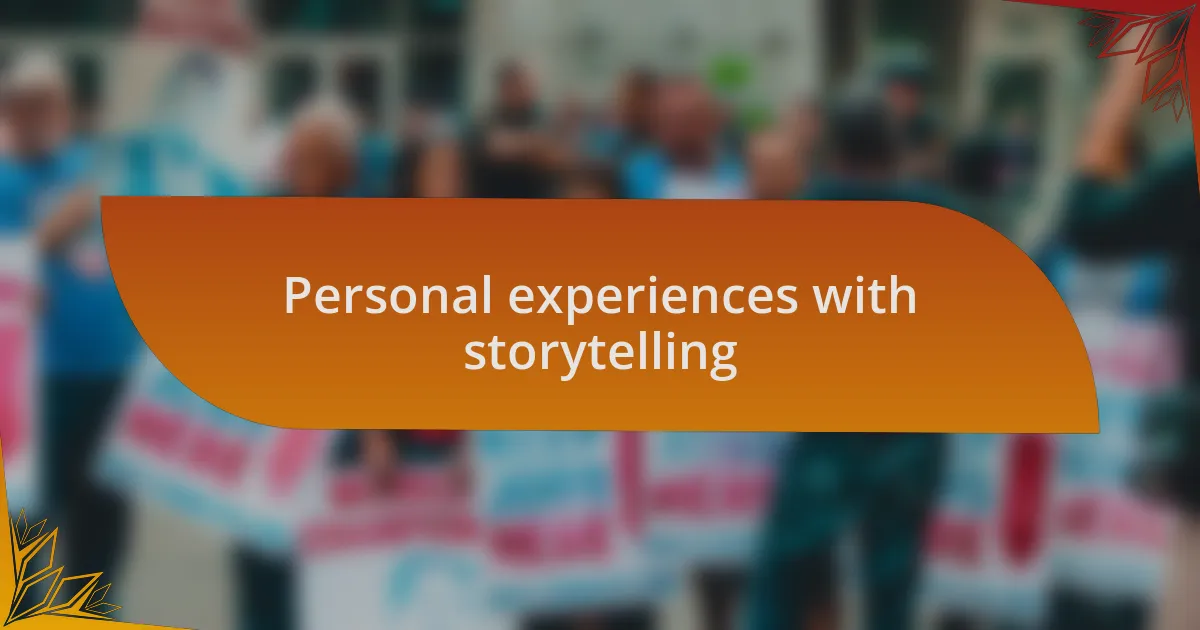
Personal experiences with storytelling
I remember my first experience with storytelling in activism like it was yesterday. I was at a community meeting, nervously waiting my turn to share my own story about my family’s struggles after a forced relocation. The fear of vulnerability was overshadowed by the realization that my words could connect with others, weaving a collective narrative that underscored our shared need for justice. How could I not share, knowing that my experience might inspire someone else to speak up?
Another moment that stands out was during a school project focusing on the impact of gentrification. I interviewed neighbors about their experiences, capturing the frustrations and loss that come with such changes. As I put together their stories, I felt an overwhelming sense of responsibility. Their narratives weren’t just facts on a page; they were lifelines to a community’s history. Can you feel the weight of that responsibility when you’re entrusted with someone’s truth?
One particularly engaging storytelling exercise involved crafting a letter to lawmakers, incorporating personal anecdotes from community members. As I wove these stories together, I felt a profound connection to each individual. It was eye-opening to see how the emotional appeal of personal narratives could bridge the gap between policymakers and the people affected by their decisions. Isn’t it fascinating how a simple letter, filled with real experiences, can hold the potential to influence change?
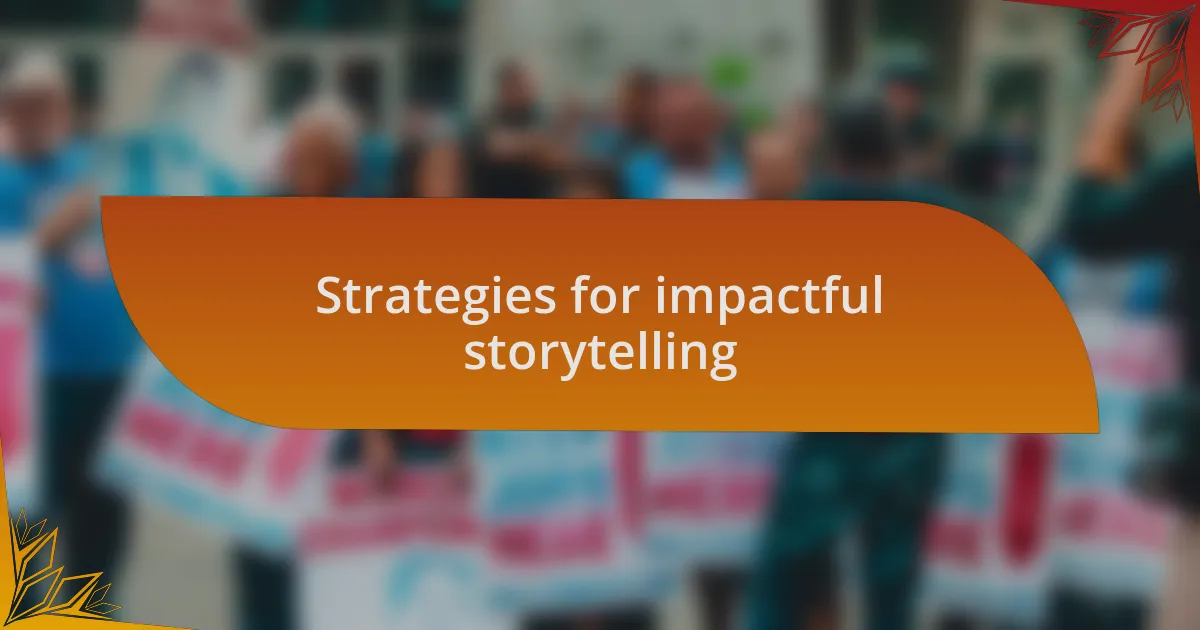
Strategies for impactful storytelling
One effective strategy I’ve discovered in storytelling for activism is to focus on the emotional core of a narrative. For instance, during our local town hall discussions, I observed how stories that evoke empathy truly resonate with the audience. When a resident shared how losing their childhood home felt more like losing a piece of their identity, it became clear that tapping into feelings can create a compelling connection with listeners. Aren’t those moments that make us reflect on our own experiences?
Another tactic I find valuable is the use of relatable metaphors. Recently, while preparing for a rally, I likened systemic injustices to an intricate web—each thread representing a different aspect of oppression that intertwines to keep people trapped. This imagery not only made the issue more tangible for my audience but also invited them to visualize their role in untangling those threads. Have you ever noticed how a simple comparison can shift perspectives and ignite passion for change?
Additionally, incorporating diverse voices in my storytelling enriches the narrative. One time, I organized a community event where we pooled together stories from various generations, highlighting their unique relationships with the land. The breadth of perspectives illustrated the fight for restitution in a way that single narratives couldn’t. Isn’t it amazing how a chorus of voices can amplify a message and strengthen a movement?